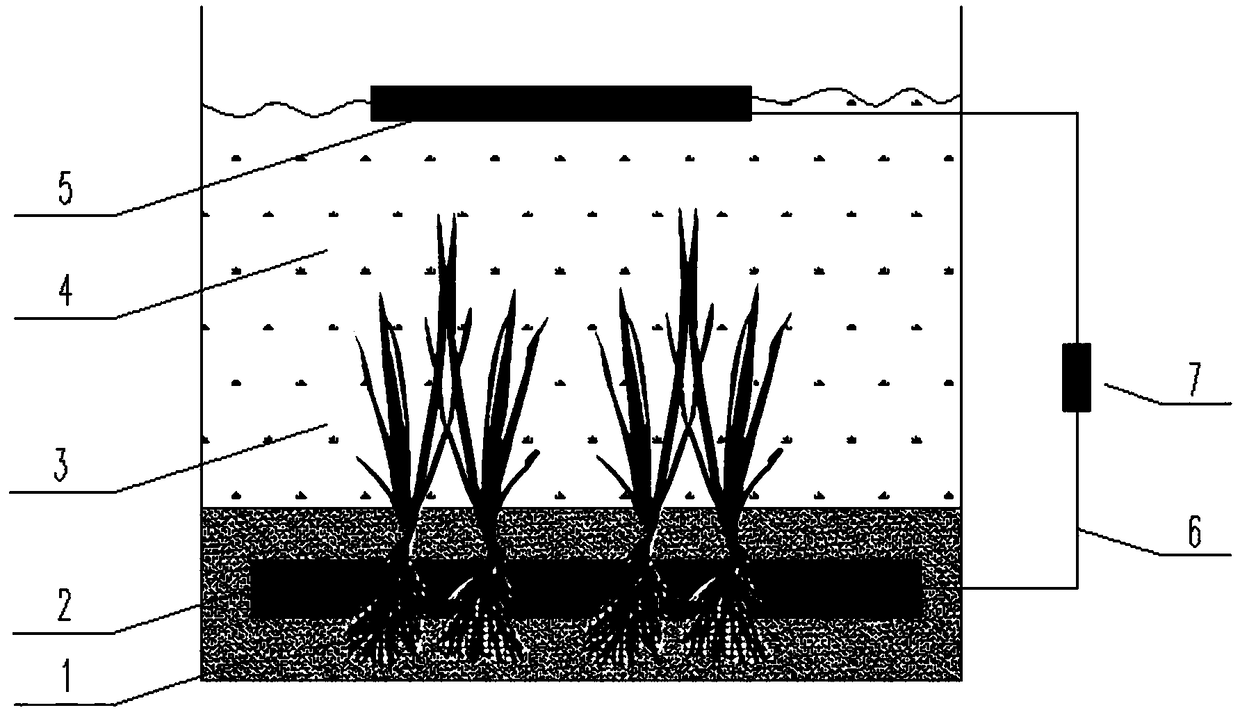Method and device for reducing endogenous nitrogen in eutrophic water body by utilizing submerged plant to couple sediment microbial fuel cell
A technology for eutrophic water and submerged plants, applied in the field of ecological restoration, can solve problems such as high nitrogen and phosphorus concentrations, difficulties, and large water level waves, and achieve the effects of promoting denitrification and denitrification, strengthening nitrogen reduction, and promoting absorption
- Summary
- Abstract
- Description
- Claims
- Application Information
AI Technical Summary
Problems solved by technology
Method used
Image
Examples
Embodiment 1
[0046] A method for reducing nitrogen in eutrophic water by coupling submerged plants with microbial fuel cells, the steps of which are as follows:
[0047] A. Plant submerged plants in the bottom mud layer of eutrophic water bodies; use the roots of submerged plants to release oxygen to form an aerobic-anoxic-anaerobic microenvironment around the rhizosphere, which is conducive to the occurrence of nitrification and denitrification processes, and at the same time The organic matter secreted by the roots of aquatic plants can be used as a carbon source for denitrification to make up for the lack of carbon source in the denitrification process that cannot proceed smoothly.
[0048] B, bury the anode plate at 3cm-10cm below the bottom mud layer-water interface, near the root system of submerged plants (5 or 7 or 8 or 10cm in diameter around the root); It is released into the overlying water layer, and the root system length of submerged plants is generally 3-10cm. The anode plat...
Embodiment 2
[0060] A device that uses microbial fuel cells coupled with submerged plants to reduce nitrogen in eutrophic water. The device is laid with a bottom mud layer 1, an anode plate 2, submerged plants 3, an overlying water layer 4, and a cathode plate from bottom to top. 5. Outer wire 6, outer resistor 7. It is characterized in that: the anode plate 2 is located 3 or 5 or 8 or 10 cm below the surface of the bottom mud 1, the roots of the submerged plants 3 pass through the openings of the anode plate 2 and penetrate into the bottom mud 1, and the cathode plate 5 is suspended on the top. In the water-covered layer 4, 30%-50% (all within this range) area is exposed to the air, one end of the outer lead 6 is connected to the anode plate 2, and the other end of the outer lead 6 is respectively connected to the external resistance 7 and the cathode plate 5 connected.
[0061] The thickness of the bottom mud layer 1 is 10 or 15 or 22 or 27 or 30 cm, which is the bottom mud in eutrophic...
Embodiment 3
[0075] The experiment compared the effect of M-SMFC system and SMFC system on nitrogen reduction in sediment and overlying water under the same environmental conditions. The results showed that:
[0076] 1) The M-SMFC group achieved the strongest endogenous ON mineralization, making the TN content in both sediment and overlying water smaller. The electricity generation process of the SMFC group promoted the conversion of organic nitrogen in the sediment to ammonia nitrogen, and the conversion of ammonia nitrogen to nitrate nitrogen, and the accumulation of nitrate in the sediment and the reduction of ammonia nitrogen. In the M-SMFC group, in addition to absorbing the sediment and overlying water, the submerged plants enriched the ammonia nitrogen in the body (see Table 4, the nitrogen content in the C. galerica was 32.2% higher), and further promoted nitrification by releasing oxygen through plant photosynthesis effect.
[0077] 2) SMFC promotes the removal of endogenous TN, ...
PUM
| Property | Measurement | Unit |
|---|---|---|
| thickness | aaaaa | aaaaa |
| height | aaaaa | aaaaa |
Abstract
Description
Claims
Application Information
 Login to View More
Login to View More - R&D
- Intellectual Property
- Life Sciences
- Materials
- Tech Scout
- Unparalleled Data Quality
- Higher Quality Content
- 60% Fewer Hallucinations
Browse by: Latest US Patents, China's latest patents, Technical Efficacy Thesaurus, Application Domain, Technology Topic, Popular Technical Reports.
© 2025 PatSnap. All rights reserved.Legal|Privacy policy|Modern Slavery Act Transparency Statement|Sitemap|About US| Contact US: help@patsnap.com



